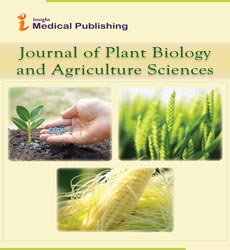Organisms the Phone Divider Polysaccharides are themselves a Food Source
Catherine Taylor Nordgård*
Department of Biotechnology, Norwegian University of Science and Technology NTNU, 7491 Trondheim, Norway
- *Corresponding Author:
- Catherine Taylor Nordgård
Department of Biotechnology, Norwegian University of Science and Technology NTNU, 7491 Trondheim, Norway
E-mail: Catherine.t.nordgard@ntnu.no
Received date: 05 August, 2021; Accepted date: 19 August, 2021; Published date: 26 August, 2021.
Citation:Dr. Catherine T N(2021) Organisms the Phone Divider Polysaccharides are themselves a Food Source. J Plant Bio Agric Sci Vol.5 No.6:100
Introduction
Plant pathology (additionally phytopathology) is the logicalinvestigation of sicknesses in plants brought about bymicroorganisms (irresistible organic entities) and naturalconditions (physiological factors). Organisms that causeirresistible illness incorporate growths, oomycetes, microbes,infections, viroids, infection like life forms, phytoplasmas,protozoa, nematodes and parasitic plants. Excluded areectoparasites like creepy crawlies, vermin, vertebrate, ordifferent bugs that influence plant wellbeing by eating of planttissues. Plant pathology likewise includes the investigation ofmicroorganism recognizable proof, sickness etiology, illnesscycles, financialeffect, plant infection the study of diseasetransmission, plant illness obstruction, what plant illnessesmean for people and creatures, pathosystem hereditaryqualities, and the executives of plant sicknesses. In manypathosystems, destructiveness is subject to hydrolases - and themore extensive class of cell divider corrupting proteins - thatdebase the cell divider. By far most of CWDPs are microbecreated and gelatin focused on (for instance, pectinesterase,pectate lyase, and pectinases). For organisms the phone dividerpolysaccharides are themselves a food source, yet generally aboundary to be overcome.Many microbes likewise developastutely when the host separates its own phone dividers,regularly during natural product ripening. Most phytopathogenicgrowths have a place with the Ascomycetes and theBasidiomycetes. The parasites replicate both physically andabiogenetically through the creation of spores and differentdesigns. Spores might be spread significant distances via air orwater, or they might be soil borne. Many soil possessing growthsare fit for living saprotrophically, doing the piece of their lifecycle in the dirt. These are facultative saprotrophs. Parasiticillnesses might be controlled using fungicides and otheragribusiness rehearses. In any case, new races of parasitesfrequently develop that are impervious to different fungicides.Biotrophic parasitic microorganisms colonize living plant tissueand get supplements from living host cells. Necrotrophicparasitic microorganisms taint and kill have tissue andconcentrate supplements from the dead host cells. Theomycetes are parasite like living beings. They incorporateprobably the most ruinous plant microorganisms including thefamily Phytophthora, which incorporates the causal specialists ofpotato late scourge and abrupt oak death.Particular types ofoomycetes are liable for root decay. Notwithstanding not beingfirmlyidentified with the growths, the oomycetes have createdcomparable contamination systems. Oomycetes are equippedfor utilizingeffector proteins to wind down a plant's protectionsin its contamination process. Plant pathologists regularly bunchthem with contagious microorganisms. There are many kinds ofplant infection, and some are even asymptomatic. Under typicalconditions, plant infections cause just a deficiency of harvestyield. Along these lines, it isn't monetarily practical to attempt tocontrol them, the exemption being the point at which theycontaminate enduring species, for example, natural producttrees. Most plant infections have little, single-abandoned RNAgenomes. Anyway some plant infections likewise have twofoldabandoned RNA or single or twofold abandoned DNA genomes.These genomes might encode just three or four proteins: areplicase, a coat protein, a development protein, to permit cellto cell development through plasmodesmata, and some of thetime a protein that permits transmission by a vector. Plantinfections can have a few additional proteins and utilize variousatomic interpretation strategies. Plant infections are for themost part communicated from one plant to another by a vector,yet mechanical and seed transmission likewise happen. Vectortransmission is frequently by a creepy crawly (for instance,aphids), yet a few parasites, nematodes, and protozoa havebeen demonstrated to be viral vectors. Much of the time, thecreepy crawly and infection are explicit for infectiontransmission, for example, the beet leafhopper that sends thewavy top infection causing illness in a few yield plants. Onemodel is mosaic sickness of tobacco where leaves arepredominated and the chlorophyll of the leaves is obliterated
Open Access Journals
- Aquaculture & Veterinary Science
- Chemistry & Chemical Sciences
- Clinical Sciences
- Engineering
- General Science
- Genetics & Molecular Biology
- Health Care & Nursing
- Immunology & Microbiology
- Materials Science
- Mathematics & Physics
- Medical Sciences
- Neurology & Psychiatry
- Oncology & Cancer Science
- Pharmaceutical Sciences
